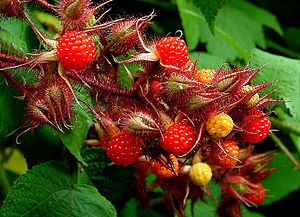Japanese grape
| Japanese grape | ||||||||||
|---|---|---|---|---|---|---|---|---|---|---|

Japanese grape ( Rubus phoenicolasius ) |
||||||||||
| Systematics | ||||||||||
|
||||||||||
| Scientific name | ||||||||||
| Rubus phoenicolasius | ||||||||||
| Maxim. |
The Japanese grape or Rotborstige raspberry ( Rubus phoenicolasius ) is a plant of the genus Rubus within the family of Rosaceae (Rosaceae).
description

The Japanese grapevine grows as a 1 to 3 meter high shrub . The two-year-old stems are initially upright, later climbing, hairy with long red-brown or wine-red hair, stalked glands and reddish spines scattered between them .
The dark green leaves are unpaired, usually three, rarely five, pinnate. The terminal leaflets are broadly ovate or round ovate, more or less lobed and double-toothed, 4 to 8 inches long and 2 to 5 inches wide and hairy on the underside. The lateral leaflets are smaller and ovate, tapering to a point and almost sessile, the stem of the terminal leaflet is 2 to 3 centimeters long. The linear, 5 to 8 millimeter long stipules are hairy, the 2 to 7 centimeters long petioles , the leaflet stalks and the central ribs are hairy and prickly.
The bracts are lanceolate, 5 to 8 millimeters long and hairy, with entire margins and bilobed at the tip. The inflorescences are panicles and stand at the end of the branches and in the upper armpits, the flower stalks are 0.5 to 1.5 centimeters long. The flower cups , like the calyx glandular-hairy tight, the red sepals are lanceolate, hairy inside, opened the heyday, after the fruit enclosing later this again releasing. The petals are whitish to slightly reddish, inverted-egg-shaped and significantly shorter than the sepals.
The numerous stamens are almost as long as the petals, the pistils are a little longer, and the ovary is almost smooth. The collective drupes are approximately round, smooth, orange to red and have a diameter of around 1 centimeter.
The number of chromosomes is 2n = 14.
The flowers appear on the rods in the second year. After fruiting, the rods die off in the next winter.
Recovery
The bright orange-red fruits are juicy, aromatic-sour and very tasty, they are suitable for direct consumption and also for making jams and jellies. The fruits seldom get mad, because insects are probably caught by the glandular secretions around the petals.
Distribution area
Originally native to western China , Korea and Japan , the grape was introduced into Europe via France in 1876 and in North America in 1890 . It is invasive in the east of the USA , and it has also become naturalized in winter-mild regions of Europe. It appreciates sunny and warm locations on humus rich and calcareous soils.
Systematics
Rubus phoenicolasius was first published in 1872 by Karl Johann Maximowicz in Bulletin de l'Academie Imperiale des Sciences de St-Petersbourg , 17 (2), pp. 160-161. This species belongs to the subgenus Idaeobatus in the genus Rubus .
literature
- North American flora , New York Botanical Garden, 1949, Vol. 22, Pt. 5, 1913, pp. 441-442: Online.
- Lu Lingdi (Lu Ling-ti) & David E. Boufford: Rubus in der Flora Of China , Volume 9, p. 212: Rubus phoenicolasius - Online.
Individual evidence
- ↑ Dericks-Tan and Vollbrecht: "On the trail of wild fruits in Europe". Abadi Verlag Alzenau 2009, ISBN 978-3-00-021129-4 , pp. 115-117
Web links
- Japanese grape. In: FloraWeb.de.
- Distribution map for Germany. In: Floraweb .
- Rubus phoenicolasius Maxim. In: Info Flora , the national data and information center for Swiss flora . Retrieved November 6, 2015.
- Thomas Meyer: Data sheet with identification key and photos at Flora-de: Flora von Deutschland (old name of the website: Flowers in Swabia )
